How Urban Expansion and Climatic Regimes Affect Groundwater Storage in China’s Major River Basins: A Comparative Analysis of the Humid Yangtze and Semi-Arid Yellow River Basins
Abstract
1. Introduction
2. Materials and Methods
2.1. Study Area
2.2. Dataset
2.2.1. Groundwater Storage Data
2.2.2. Climate and Hydrological Data
2.2.3. Land Use Data and Population Data
2.3. Methodology
2.3.1. Classification of Three Types of Cities
2.3.2. Groundwater Storage Variation Calculation
2.3.3. Climate and Human Contribution
- GWSAcc = Climate-driven groundwater storage anomaly;
- GWSAac = Anthropogenic-driven groundwater storage anomaly;
- GWSA = Original groundwater storage anomaly;
- P = Monthly precipitation anomaly;
- T = Monthly temperature anomaly;
- a, b, c = Regression coefficients estimated at grid scale.
3. Results
3.1. Distribution of Three Types of Cities in YZB and YRB
3.2. GWSA Variations in Three Types of Cities
3.3. Climatic Regimes in YZB and YRB
3.4. Contributions of Climate and Human Activities to Urban GWSAs
4. Discussion
4.1. Implications of Dual Impacts of Urbanization on Groundwater Storage
4.2. Impacts of Contrasting Climatic Regimes on Groundwater Storage
4.3. Limitations and Uncertainties
5. Conclusions
Supplementary Materials
Author Contributions
Funding
Data Availability Statement
Acknowledgments
Conflicts of Interest
References
- Wada, Y. Modeling Groundwater Depletion at Regional and Global Scales: Present State and Future Prospects. Surv. Geophys. 2016, 37, 419–451. [Google Scholar] [CrossRef]
- Sun, S.; Liu, H.; Konar, M.; Fu, G.; Fang, C.; Huang, Z.; Li, G.; Qi, W.; Tang, Q. Urban groundwater supplies facing dual pressures of depletion and contamination in China. Proc. Natl. Acad. Sci. USA 2025, 22, e2412338122. [Google Scholar] [CrossRef] [PubMed]
- O’Driscoll, M.; Clinton, S.; Jefferson, A.; Manda, A.; McMillan, S. Urbanization effects on watershed hydrology and in-stream processes in the southern United States. Water 2010, 2, 605–648. [Google Scholar] [CrossRef]
- Zaryab, A.; Nassery, H.R.; Alijani, F. The effects of urbanization on the groundwater system of the Kabul shallow aquifers, Afghanistan. Hydrogeol. J. 2022, 30, 429–443. [Google Scholar]
- Li, C.; Sun, G.; Caldwell, P.V.; Cohen, E.; Fang, Y.; Zhang, Y.; Oudin, L.; Sanchez, G.M.; Meentemeyer, R.K. Impacts of urbanization on watershed water balances across the conterminous United States. Water Resour. Res. 2020, 56, e2019WR026574. [Google Scholar]
- Li, C.; Sun, G.; Cohen, E.; Zhang, Y.; Xiao, J.; McNulty, S.G.; Meentemeyer, R.K. Modeling the impacts of urbanization on watershed-scale gross primary productivity and tradeoffs with water yield across the conterminous United States. J. Hydrol. 2020, 583, 124581. [Google Scholar]
- Sun, G.; Hao, L. Research progress on the interaction between evapotranspiration processes and service functions in ecosystems. In Lecture on Modern Ecology (X): Core Topics, Research Progress and Future Challenges; Wu, J.K., Ed.; Higher Education Press: Beijing, China, 2023. [Google Scholar]
- Nie, N.; Zhang, W.C.; Chen, H.; Zhao, D.; Liu, M. Temporal variation characteristics and attribution analysis of water storage changes in the Yangtze River Basin. Adv. Water Sci. 2021, 32, 396–407. [Google Scholar]
- Xiong, J.H.; Guo, S.L.; Wang, J.; Yin, J.; Li, N. Change and attribution of land water reserves in the Yangtze River Basin. J. Wuhan Univ. (Inf. Sci. Ed.) 2024, 49, 2241–2248. [Google Scholar]
- Dong, G.Q. Study on Drought Monitoring in the Yangtze River Basin Using Gravity Satellites GRACE and GRACE-FO. Master’s Thesis, Xiangtan University, Xiangtan, China, 2023. [Google Scholar]
- United Nations. The United Nations World Water Development Report 2022. Groundwater: Making the Invisible Visible; UNESCO: Paris, France, 2022. [Google Scholar]
- Guan, X.D.; Shen, X.H.; Li, M.Y.; Huang, J.P.; Wei, Z.M.; Ma, Y.L. Impact of urbanization on groundwater in the Yellow River Basin. Chin. J. Atmos. Sci. 2023, 46, 9–17. [Google Scholar]
- Yao, D.; Zhang, Z.W.; Han, W.W. Differentiating the different components of water storage changes in the Yellow River Basin caused by climate change and human activities. Arid. Reg. Geogr. 2025, 48, 190–201. [Google Scholar]
- Yin, Y.; Tang, Q.; Liu, X.; Zhang, X. Water scarcity under various Socio-economic pathways and its potential effects on food production in the Yellow River Basin. Hydrol. Earth Syst. Sci. 2017, 21, 791–804. [Google Scholar]
- Xie, J.; Xu, Y.P.; Wang, Y.; Gu, H.; Wang, F.; Pan, S. Influences of climatic variability and human activities on terrestrial water storage variations across the Yellow River basin in the recent decade. J. Hydrol. 2019, 579, 124218. [Google Scholar] [CrossRef]
- Zhang, B.Q.; Shao, R.; Zhao, X.N.; Wu, P. Effects of large-scale vegetation restoration on ecohydrological processes in the Loess Plateau. Chin. J. Appl. Basic Eng. Sci. 2020, 28, 594–606. [Google Scholar]
- Liu, J.H.; Zhou, M.L.; Shao, W.W. Spatial and temporal evolution characteristics and influencing factors of groundwater reserves in the Yellow River Basin. People’s Yellow River 2024, 46, 67–73. [Google Scholar]
- Zhang, X.P.; Zhang, L.; Wang, Y.; Mu, X.M. Spatiotemporal response of annual runoff to land use change in the middle Yellow River. Sci. Soil Water Conserv. China 2009, 7, 19–26. [Google Scholar]
- Green, T.R.; Taniguchi, M.; Kooi, H.; Gurdak, J.J.; Allen, D.M.; Hiscock, K.M.; Treidel, H.; Aureli, A. Beneath the surface of global change: Impacts of climate change on groundwater. J. Hydrol. 2011, 405, 532–560. [Google Scholar] [CrossRef]
- Chen, J.; Famigliett, J.S.; Scanlon, B.R.; Rodell, M. Groundwater Storage Changes: Present Status from GRACE Observations. Surv. Geophys. 2016, 37, 397–417. [Google Scholar] [CrossRef]
- Hao, L.; Sun, G.; Liu, Y.; Wan, J.; Qin, M.; Qian, H.; Liu, C.; Zheng, J.; John, R.; Fan, P.; et al. Urbanization dramatically altered the water balances of a paddy field-dominated basin in southern China. Hydrol. Earth Syst. Sci. 2015, 19, 3319–3331. [Google Scholar] [CrossRef]
- Carlson, M.A.; Lohse, K.A.; Mcintosh, J.C.; McLain, J.E. Impacts of urbanization on groundwater quality and recharge in a semi-arid alluvial basin. J. Hydrol. 2011, 409, 196–211. [Google Scholar] [CrossRef]
- IPCC. Climate Change 2023: Synthesis Report. Contribution of Working Groups I, II and III to the Sixth Assessment Report of the Intergovernmental Panel on Climate Change; Core Writing Team, Lee, H., Romero, J., Eds.; IPCC: Geneva, Switzerland, 2023; pp. 35–115. [Google Scholar]
- Wei, X.H.; Sun, G. Watershed Ecosystem Processes and Management, 2nd ed.; Higher Education Press: Beijing, China, 2023. [Google Scholar]
- Tapley, B.D.; Bettadpur, S.; Watkins, M.M.; Reigber, C. The Gravity recovery and climate experiment: Mission overview and early results. Geophys. Res. Lett. 2004, 31, L09607. [Google Scholar] [CrossRef]
- Tapley, B.D.; Bettapur, S.; Ries, J.; Thompson, P.F.; Watkins, M.M. GRACE measurements of mass variability in the earth system. Science 2004, 305, 503–505. [Google Scholar] [CrossRef] [PubMed]
- Wahr, J.; Swenson, S.; Zlotnicki, V.; Velicogna, I. Time-variable gravity from GRACE: First results. Geophys. Res. Lett. 2004, 31, L11501. [Google Scholar] [CrossRef]
- Rodell, M.; Houser, P.; Jambor, U.; Gottschalck, J.; Mitchell, K.; Meng, C.; Arsenault, K.; Cosgrove, B.; Radakovich, J.; Bosilovich, M. The global land data assimilation system. Bull. Am. Meteorol. Soc. 2004, 85, 381–394. [Google Scholar]
- Hiroko, B.; Rodell, M.; Huang, J. GLDAS Noah Land Surface Model L4 monthly 0.25 × 0.25 degree V2.1; Goddard Earth Sciences Data and Information Services Center (GES DISC): Greenbelt, MD, USA, 2016. [Google Scholar]
- Yin, W.J.; Hu, L.T.; Wang, J.R. Changes of groundwater storage variation based on GRACE data at the Beishan area, Gansu Province. Hydrogeol. Eng. Geol. 2015, 42, 29–34. [Google Scholar]
- Peng, S.Z.; Ding, Y.X.; Liu, W.Z.; Li, Z. 1 km monthly temperature and precipitation dataset for China from 1901 to 2017. Earth Syst. Sci. Data 2019, 11, 1931–1946. [Google Scholar]
- Peng, S.Z.; Ding, Y.X.; Wen, Z.M.; Chen, Y.M.; Cao, Y.; Ren, J.Y. Spatiotemporal change and trend analysis of potential evapotranspiration over the Loess Plateau of China during 2011–2100. Agric. For. Meteorol. 2017, 233, 183–194. [Google Scholar]
- Huang, C.S.; Zhou, Y.; Zhang, S.N.; Wang, J.T.; Liu, F.M.; Gong, C.; Yi, C.Y.; Li, L.; Zhou, H.; Wei, L.S.; et al. Groundwater resources in the Yangtze River Basin and its current development and utilization. Geol. China 2021, 48, 979–1000. [Google Scholar]
- Senay, G.B.; Bohms, S.; Singh, R.K.; Gowda, P.H.; Velpuri, N.M.; Alemu, H.; Verdin, J.P. Operational Evapotranspiration Mapping Using Remote Sensing and Weather Data Sets: A New Parameterization for the SSEBOP Approach. J. Am. Water Resour. Assoc. 2013, 49, 577–591. [Google Scholar] [CrossRef]
- WorldPop; CIESIN (Center for International Earth Science Information Network). Global High Resolution Population Denominators Project-Funded by the Bill and Melinda Gates Foundation (OPP1134076) [EB/OL]. 2018. Available online: https://www.worldpop.org/ (accessed on 2 May 2023).
- Xu, X.L.; Liu, J.Y.; Zhang, S.W.; Li, R.; Yan, C.; Wu, S. Multiperiod Land Use Remote Sensing Monitoring Dataset in China (CNLUCC) [EB/OL]; Resource and Environmental Science Data Registration and Publication System; Institute of Geographic Sciences and Resources, Chinese Academy of Sciences: Beijing, China, 2018; Available online: https://www.resdc.cn/DOI/DOI.aspx?DOIID=54 (accessed on 3 May 2023). [CrossRef]
- Wang, F.; Lai, H.X.; Li, Y.B.; Feng, K.; Tian, Q.Q.; Guo, W.X.; Qu, Y.P.; Yang, H.B. Spatio-temporal evolution and teleconnection factor analysis of groundwater drought based on the GRACE mascon model in the Yellow River Basin. J. Hydrol. 2023, 626, 130349. [Google Scholar]
- Humphrey, V.; Gudmundsson, L.; Seneviratne, S.I. A global reconstruction of climate-driven subdecadal water storage variability. Geophys. Res. Lett. 2017, 44, 2300–2309. [Google Scholar]
- Liu, B.; Zou, X.; Yi, S.; Sneeuw, N.; Cai, J.; Li, J. Identifying and separating climate and human driven water storage anomalies using GRACE satellite data. Remote Sens. Environ. 2021, 263, 112559. [Google Scholar] [CrossRef]
- Liu, M.Z.; Pe, H.W.; Shen, Y.J. Evaluating dynamics of GRACE groundwater and its drought potential in Taihang Mountain Region, China. J. Hydrol. 2022, 612, 128156. [Google Scholar] [CrossRef]
- Zhang, S.L.; Feng, P. Change of groundwater resources in Haihe River Basin and its impact on ecological environment. Water Resour. Hydropower Technol. 2003, 34, 47–49. [Google Scholar]
- Suriya, S.; Mudgal, B.V. Impact of urbanization on flooding: The Thirusoolam sub watershed—A case study. J. Hydrol. 2012, 412–413, 210–219. [Google Scholar] [CrossRef]
- Foley, J.A.; DeFries, R.; Asner, G.P.; Barford, C.; Bonan, G.; Carpenter, S.R.; Chapin, F.S.; Coe, M.T.; Daily, G.C.; Gibbs, H.K.; et al. Global consequences of land use. Science 2005, 309, 570–574. [Google Scholar] [CrossRef]
- Luong, V.V. Effects of urbanization on groundwater level in aquifers of Binh Duong Province, Vietnam. J. Groundw. Sci. Eng. 2021, 9, 20–36. [Google Scholar]
- Barringer, T.H.; Reiser, R.G.; Price, C.V. Potential effects of development on flow characteristics of two New Jersey streams. J. Am. Water Resour. Assoc. 1994, 30, 283–295. [Google Scholar] [CrossRef]
- Forman, R.T.T. Urban Ecology—Science of Cities; Cambridge University Press: New York, NY, USA, 2014. [Google Scholar]
- Paul, M.J.; Meyer, J.L. Streams in the urban landscape. Annu. Rev. Ecol. Syst. 2001, 32, 333–365. [Google Scholar] [CrossRef]
- Zhu, L.; Sun, J.C.; Liu, J.T.; Liu, J.; Lv, X.L. Study on the impact of urbanization on groundwater system in Lanzhou City. J. Water Resour. Water Eng. 2014, 25, 111–115. [Google Scholar]
- Barron, O.V.; Barr, A.D.; Dom, M.J. Effect of urbanisation on the water balance of a catchment with shallow groundwater. J. Hydrol. 2013, 485, 162–176. [Google Scholar] [CrossRef]
- Ellison, D.; Pokorný, J.; Wild, M. Even cooler insights: On the power of forests to (water the Earth and) cool the planet. Glob. Chang. Biol. 2024, 30, e17195. [Google Scholar] [CrossRef]
- Wang, X.D. Changes of Groundwater Reserves in the Yellow River Basin Based on GRACE Products and Its Influencing Factors; Northwest A&F University: Xianyang, China, 2023. [Google Scholar]
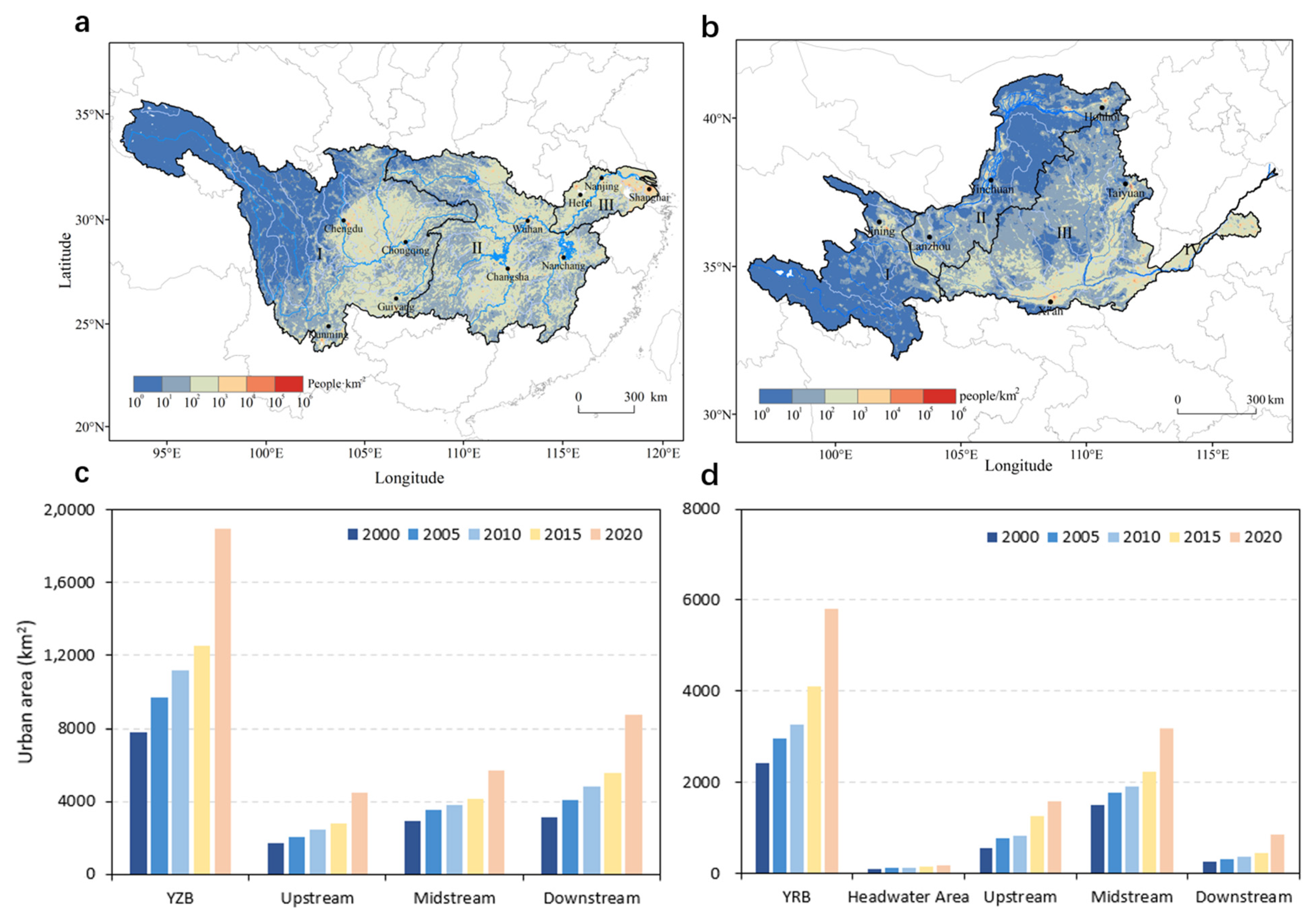
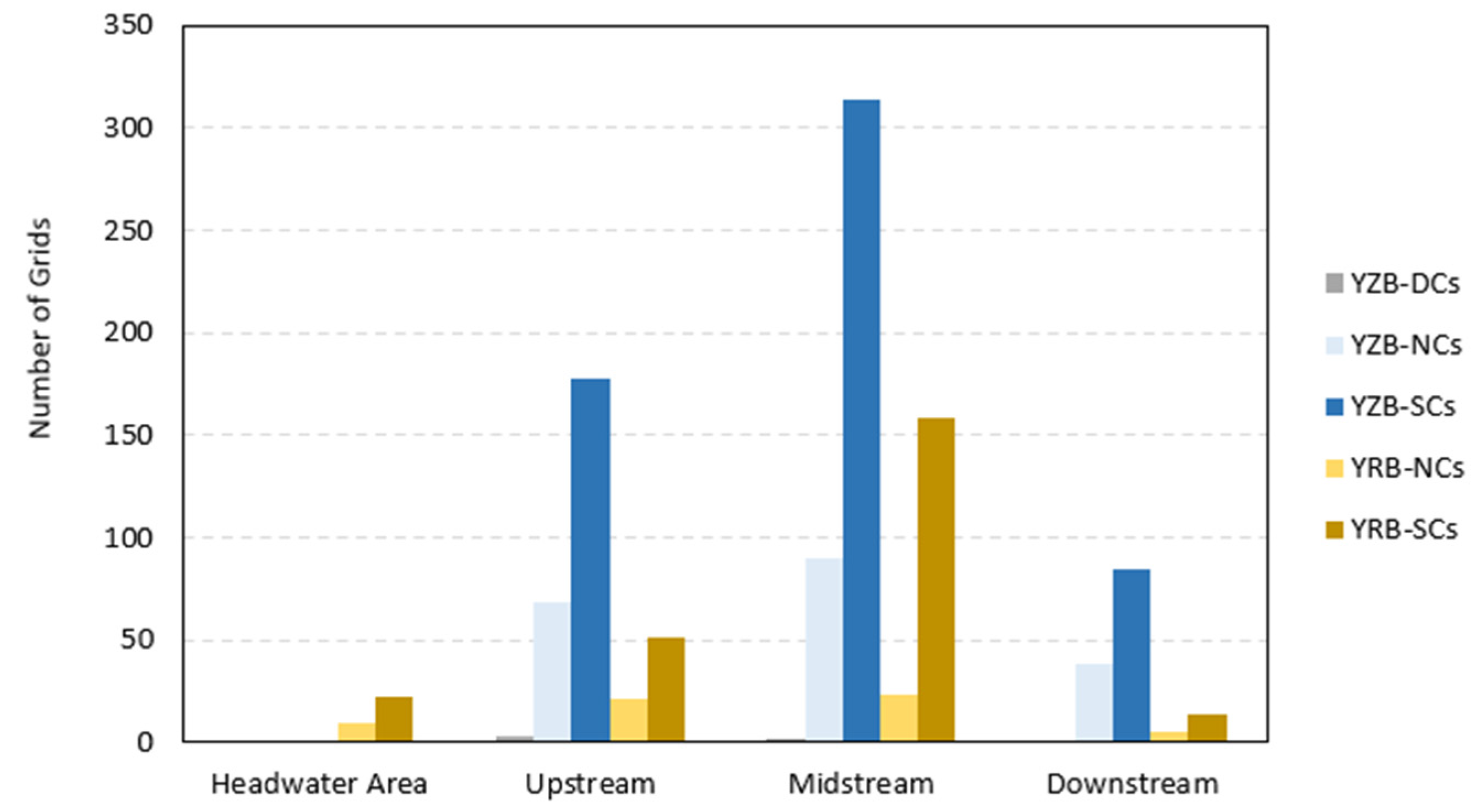

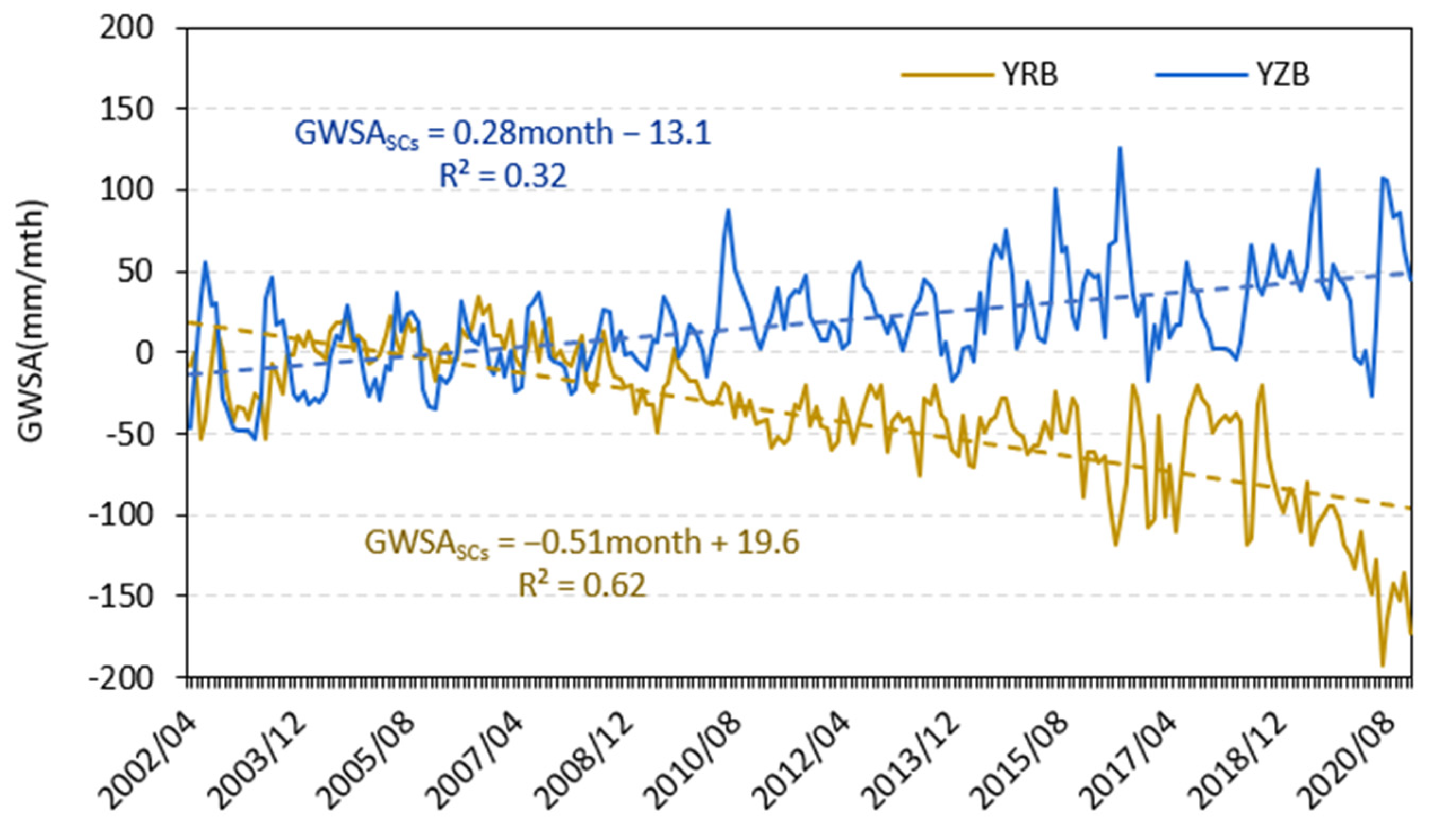
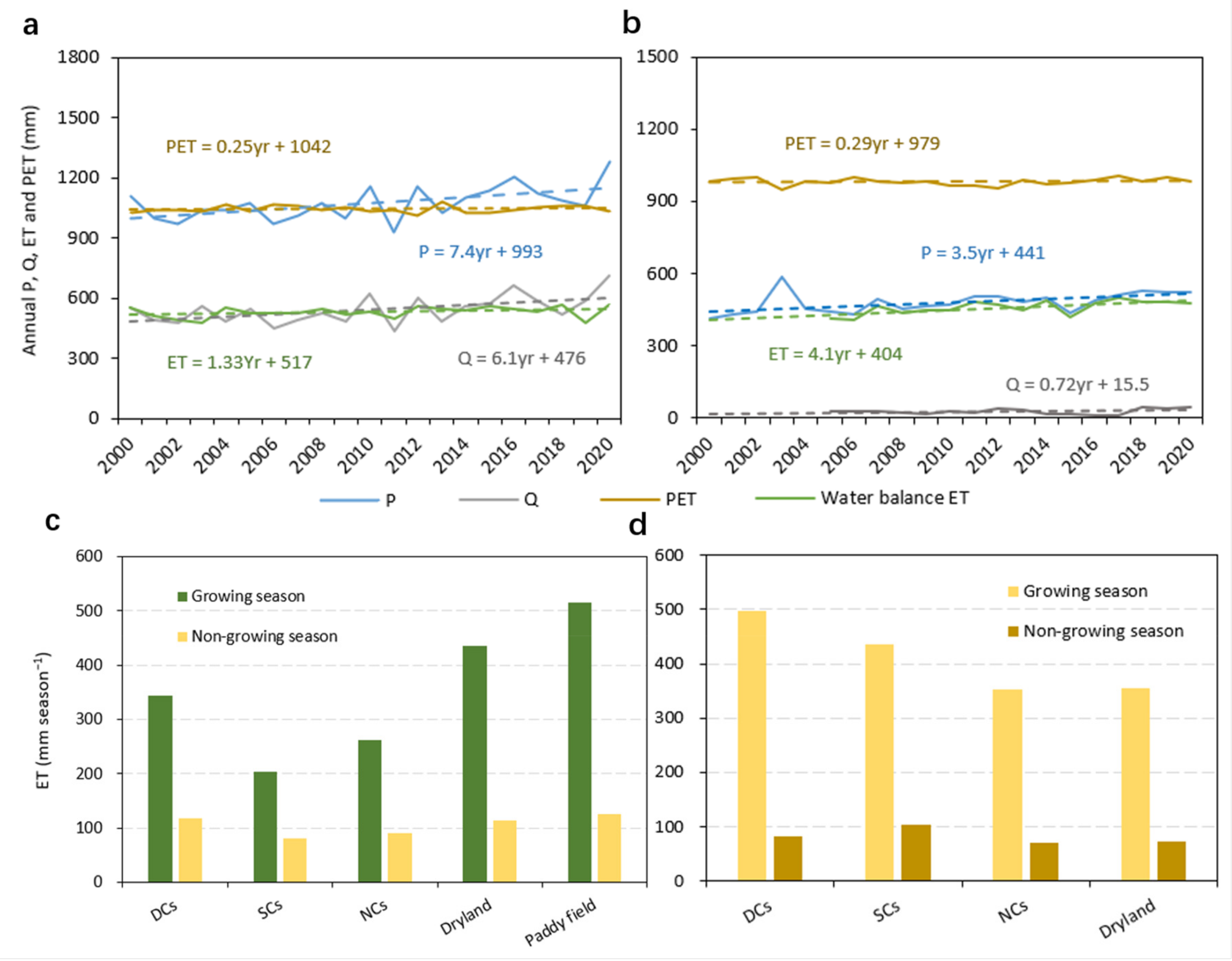
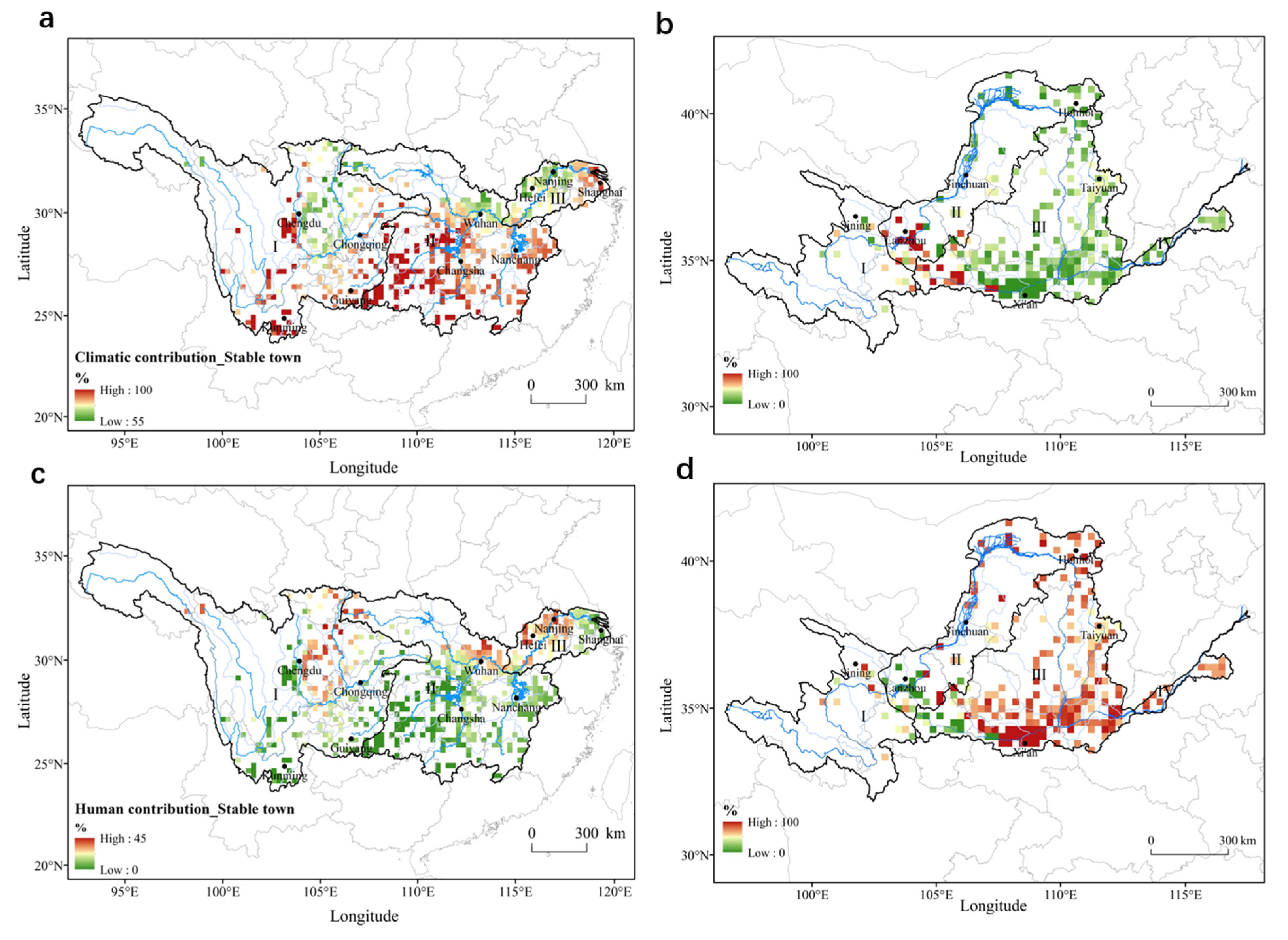

| Trend (mm/yr) | DCs | NCs | SCs | Dryland | Paddy |
|---|---|---|---|---|---|
| Yangtze River Basin | 6.14 | 3.58 | 3.36 | 4.17 | 3.28 |
| Upstream | 6.14 | 4.78 | 4.42 | 4.52 | 4.43 |
| Midstream | 6.13 | 4.13 | 4.11 | 3.22 | 4.56 |
| Downstream | -- | 2.04 | 1.73 | -- | 1.95 |
| Yellow River Basin | −6.12 | −6.16 | −5.01 | −5.00 | -- |
| Headwater Area | -- | −2.17 | −3.05 | −1.60 | -- |
| Upstream | -- | −4.14 | −3.91 | −3.20 | -- |
| Midstream | −6.12 | −6.26 | −5.56 | −5.33 | -- |
| Downstream | -- | −9.09 | −8.87 | −9.06 | -- |
| Magnitude (mm)/Trend (mm/yr) | P/PT | Q/QT | ET/ETT | PET/PETT | GWSAT | C/H |
|---|---|---|---|---|---|---|
| YZB | 1074/7.4 | 543/6.1 | 531/1.3 | 1045/0.25 | 3.47 | 86%/14% |
| YRB | 479/3.5 | 25/0.7 | 459/4.1 | 981/0.29 | −5.59 | 28%/72% |
Disclaimer/Publisher’s Note: The statements, opinions and data contained in all publications are solely those of the individual author(s) and contributor(s) and not of MDPI and/or the editor(s). MDPI and/or the editor(s) disclaim responsibility for any injury to people or property resulting from any ideas, methods, instructions or products referred to in the content. |
© 2025 by the authors. Licensee MDPI, Basel, Switzerland. This article is an open access article distributed under the terms and conditions of the Creative Commons Attribution (CC BY) license (https://creativecommons.org/licenses/by/4.0/).
Share and Cite
Zhou, W.; Hao, L. How Urban Expansion and Climatic Regimes Affect Groundwater Storage in China’s Major River Basins: A Comparative Analysis of the Humid Yangtze and Semi-Arid Yellow River Basins. Remote Sens. 2025, 17, 1292. https://doi.org/10.3390/rs17071292
Zhou W, Hao L. How Urban Expansion and Climatic Regimes Affect Groundwater Storage in China’s Major River Basins: A Comparative Analysis of the Humid Yangtze and Semi-Arid Yellow River Basins. Remote Sensing. 2025; 17(7):1292. https://doi.org/10.3390/rs17071292
Chicago/Turabian StyleZhou, Weijing, and Lu Hao. 2025. "How Urban Expansion and Climatic Regimes Affect Groundwater Storage in China’s Major River Basins: A Comparative Analysis of the Humid Yangtze and Semi-Arid Yellow River Basins" Remote Sensing 17, no. 7: 1292. https://doi.org/10.3390/rs17071292
APA StyleZhou, W., & Hao, L. (2025). How Urban Expansion and Climatic Regimes Affect Groundwater Storage in China’s Major River Basins: A Comparative Analysis of the Humid Yangtze and Semi-Arid Yellow River Basins. Remote Sensing, 17(7), 1292. https://doi.org/10.3390/rs17071292








